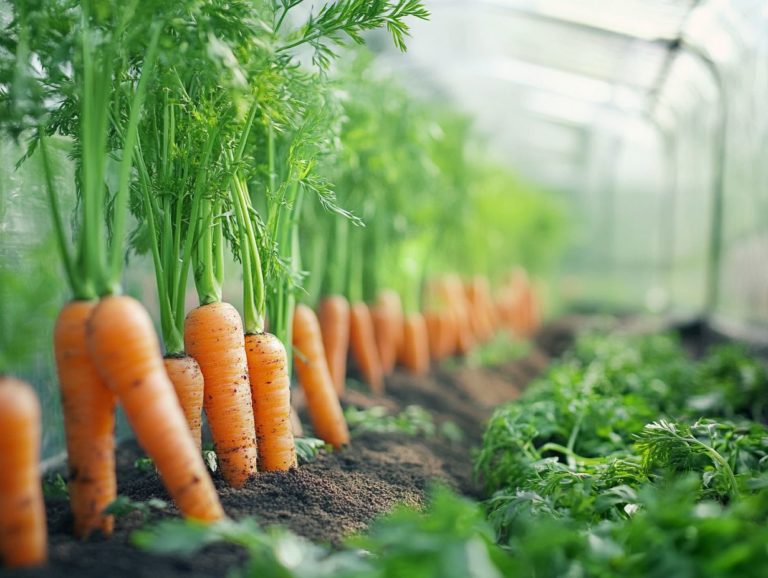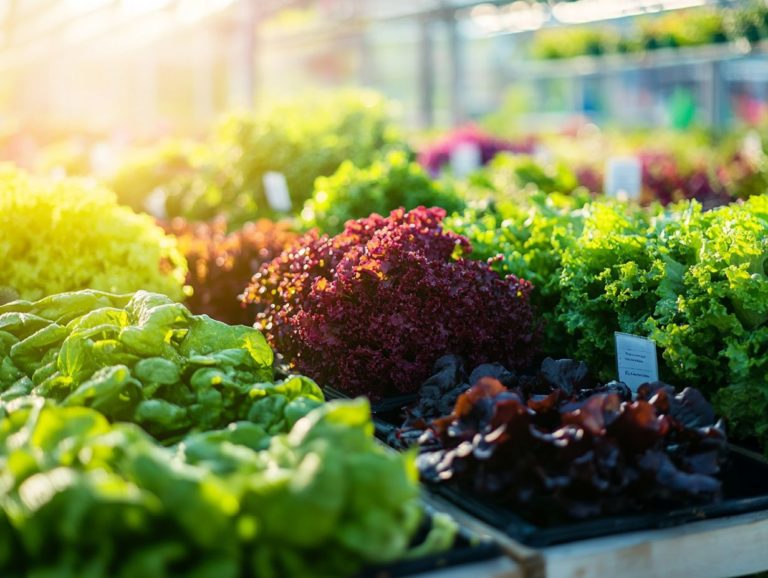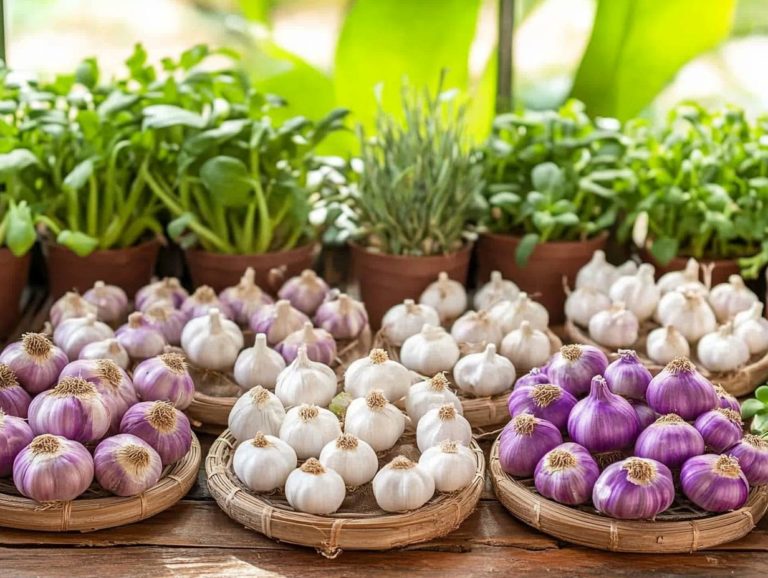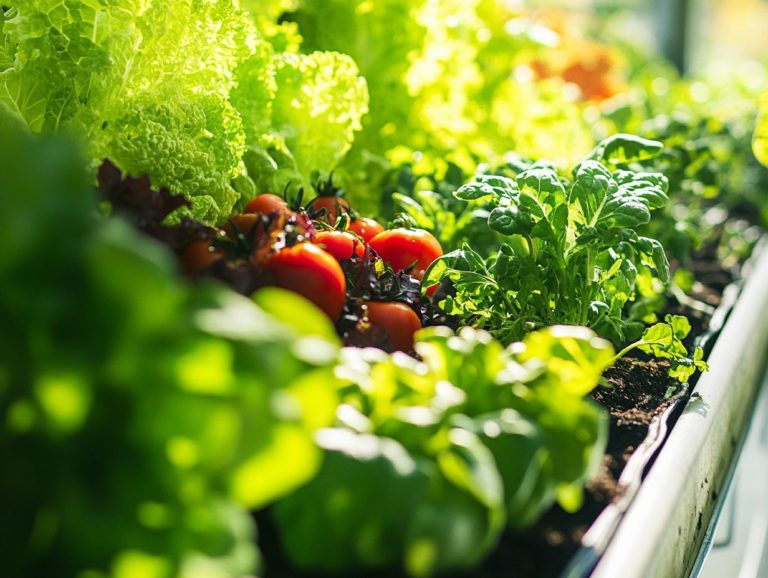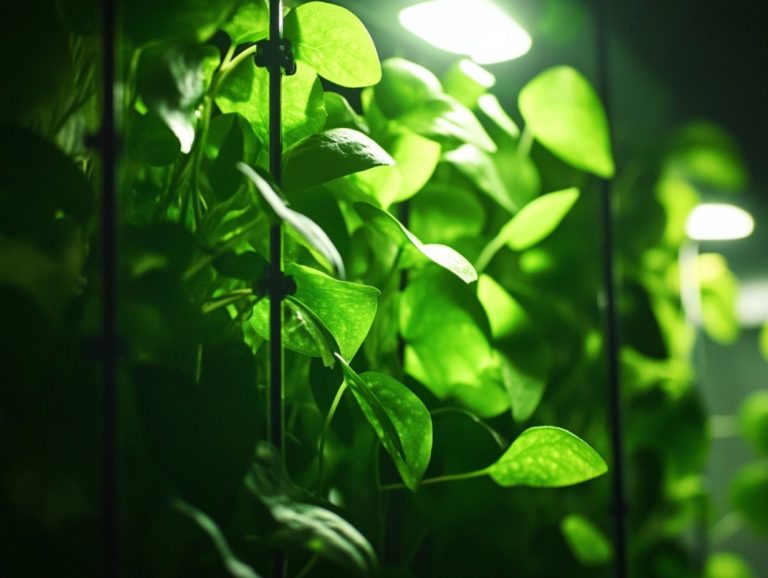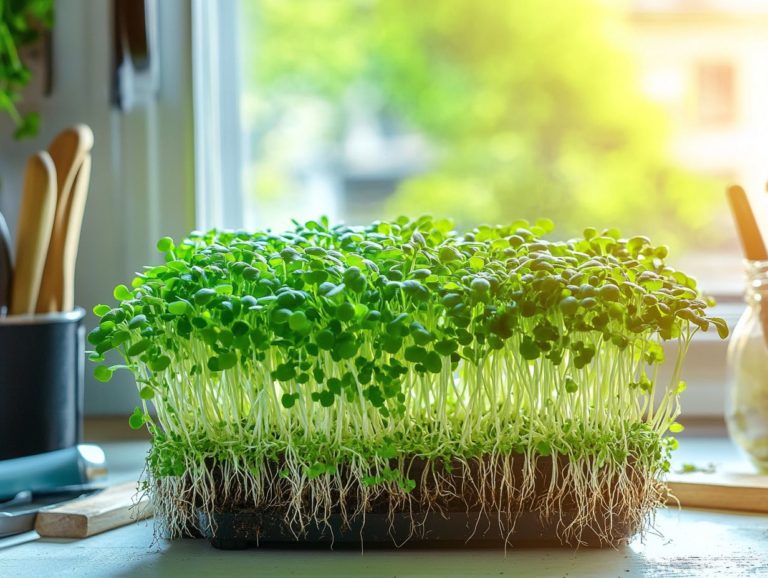“Best Hydroponic Plants for Vertical Gardens”
Indoor vertical gardens offer a breathtaking solution for infusing greenery into your environment, particularly when traditional gardening isn t feasible.
Selecting the right plants is essential for optimizing both visual charm and productivity. Delve into the myriad benefits of vertical gardening, consider the crucial factors when choosing plants, and discover the top hydroponic options that excel in these innovative arrangements.
Whether you re an experienced gardener or just beginning your journey, you ll uncover inspiration and practical tips to help you cultivate your own vibrant oasis.
Contents
- Key Takeaways:
- Choosing the Right Plants for Vertical Gardens
- Top Hydroponic Plants for Vertical Gardens
- Frequently Asked Questions
- 1. What are the best hydroponic plants for vertical gardens?
- 2. Can I grow root vegetables in a vertical hydroponic garden?
- 3. Do I need special equipment to grow hydroponic plants in a vertical garden?
- 4. What are the advantages of growing hydroponic plants in a vertical garden?
- 5. Can I grow flowering plants in a vertical hydroponic garden?
- 6. How do I maintain a vertical hydroponic garden?
Key Takeaways:
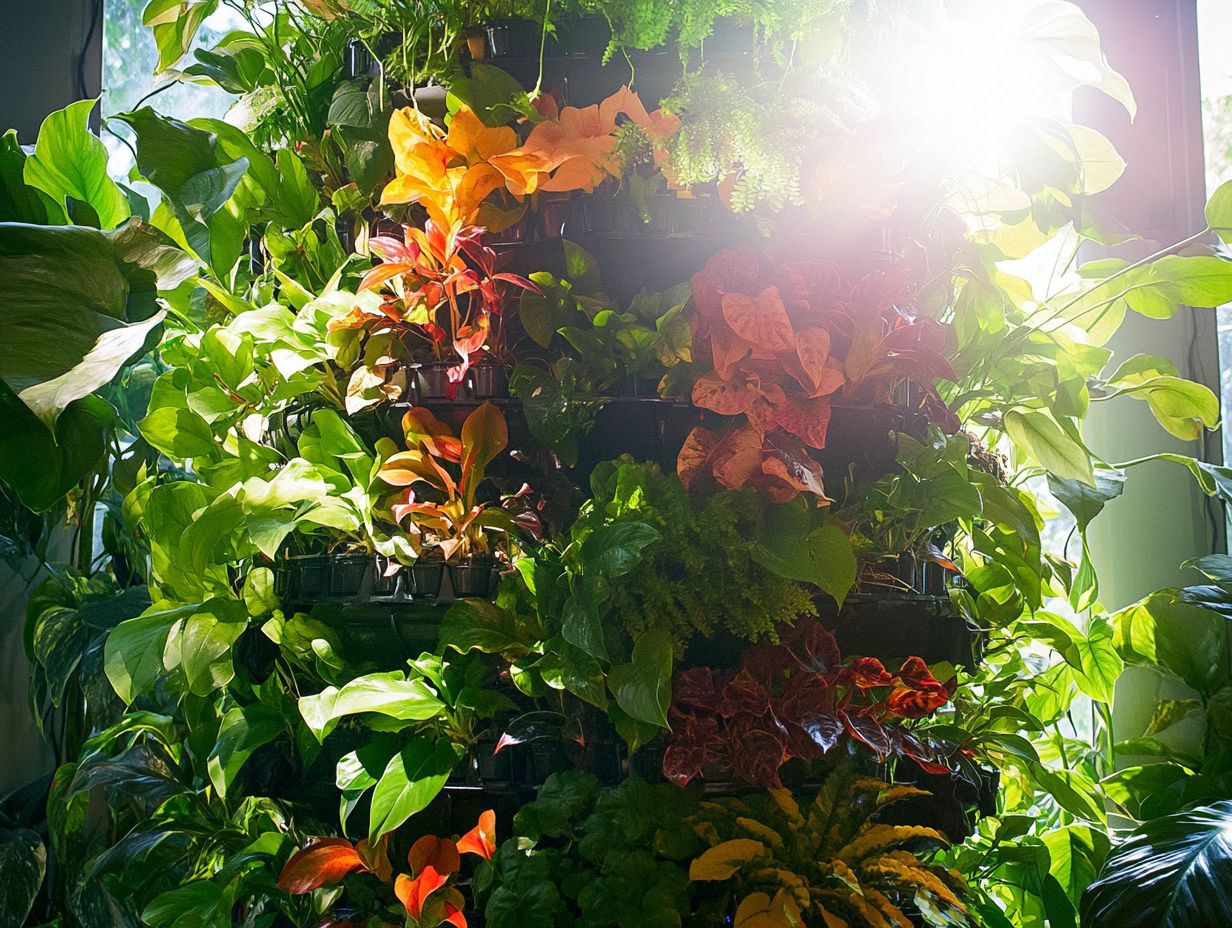
- Vertical gardens offer numerous benefits, including maximizing space, reducing water usage, and providing fresh produce.
- When choosing plants for your vertical garden, consider factors such as space, lighting, and water requirements.
- Some of the best hydroponic plants for vertical gardens include strawberries, lettuce, tomatoes, herbs, and spinach.
Benefits and Advantages
Indoor vertical gardens present a remarkable array of benefits, transforming your perspective on urban farming and home gardening. These innovative systems are particularly advantageous for those of you with limited space.
They enable you to cultivate your own food right in your kitchen or living space. By employing a soilless growing method or vertical garden boxes, you can indulge in fresh produce like lettuce, tomatoes, and herbs no sprawling outdoor garden required.
The use of grow lights and sustainable gardening practices not only enhances soil health and plant nutrition but also ensures your indoor garden flourishes, supporting your journey toward self-sufficiency and eco-friendly living.
They also improve indoor air quality by filtering pollutants and releasing oxygen. As an urban dweller, you can take pride in growing your own fresh ingredients, enriching both your culinary adventures and nutritional intake.
The maintenance of these systems is designed for minimal effort, making vertical gardening accessible even for those with hectic lifestyles. Investing in such a garden can yield notable savings on groceries while fostering a deeper connection with nature and promoting sustainable practices in the bustling city landscape.
Choosing the Right Plants for Vertical Gardens
Selecting the right plants for your vertical garden is essential for optimizing your indoor gardening space. You must consider factors such as light, water, and nutrients to ensure success.
By choosing plants that flourish in vertical environments, you can elevate your gardening experience, resulting in a rich bounty of culinary herbs, fresh produce, and even delightful edible flowers.
With the appropriate vertical planters and gardening supplies, you have the opportunity to craft an aesthetically pleasing kitchen garden that enhances the beauty of your home while promoting sustainable practices and self-sufficiency.
Factors to Consider
When you embark on your vertical gardening journey, there are several key factors to carefully consider to create a successful indoor vertical garden.
From assessing the available space and selecting the right soilless growing method to understanding the specific care requirements for your chosen herbs and veggies, each decision profoundly impacts the health and productivity of your garden.
By adhering to essential gardening tips for plant maintenance and care, you can significantly enhance both your yield and the joy of nurturing home-grown herbs.
Evaluating light levels in your space is vital, as many plants flourish in bright, indirect sunlight, while others thrive in low-light conditions. Water needs are another critical consideration; some varieties may crave moisture, while others prefer drier soil to avoid root rot.
Proactive pest control techniques, such as introducing beneficial insects or selecting pest-resistant varieties, will help safeguard your green oasis. By keeping these parameters in mind, you can cultivate a thriving vertical sanctuary that not only beautifies your environment but also contributes to sustainable living.
Join the movement for greener living! Start planning your vertical garden today!
Top Hydroponic Plants for Vertical Gardens
Maximizing yield in your indoor vertical garden largely depends on choosing the right hydroponic plants that thrive in a vertical setup. Among the best options for hydroponic systems are a variety of greens, herbs, and even edible flowers. Each of these plants can flourish in compact spaces while significantly enriching your kitchen garden.
With a thoughtful strategy, you can grow vibrant strawberries, nutrient-rich lettuce, and aromatic herbs. These not only elevate your culinary creations but also turn your living space into a sensory delight.
1. Strawberries
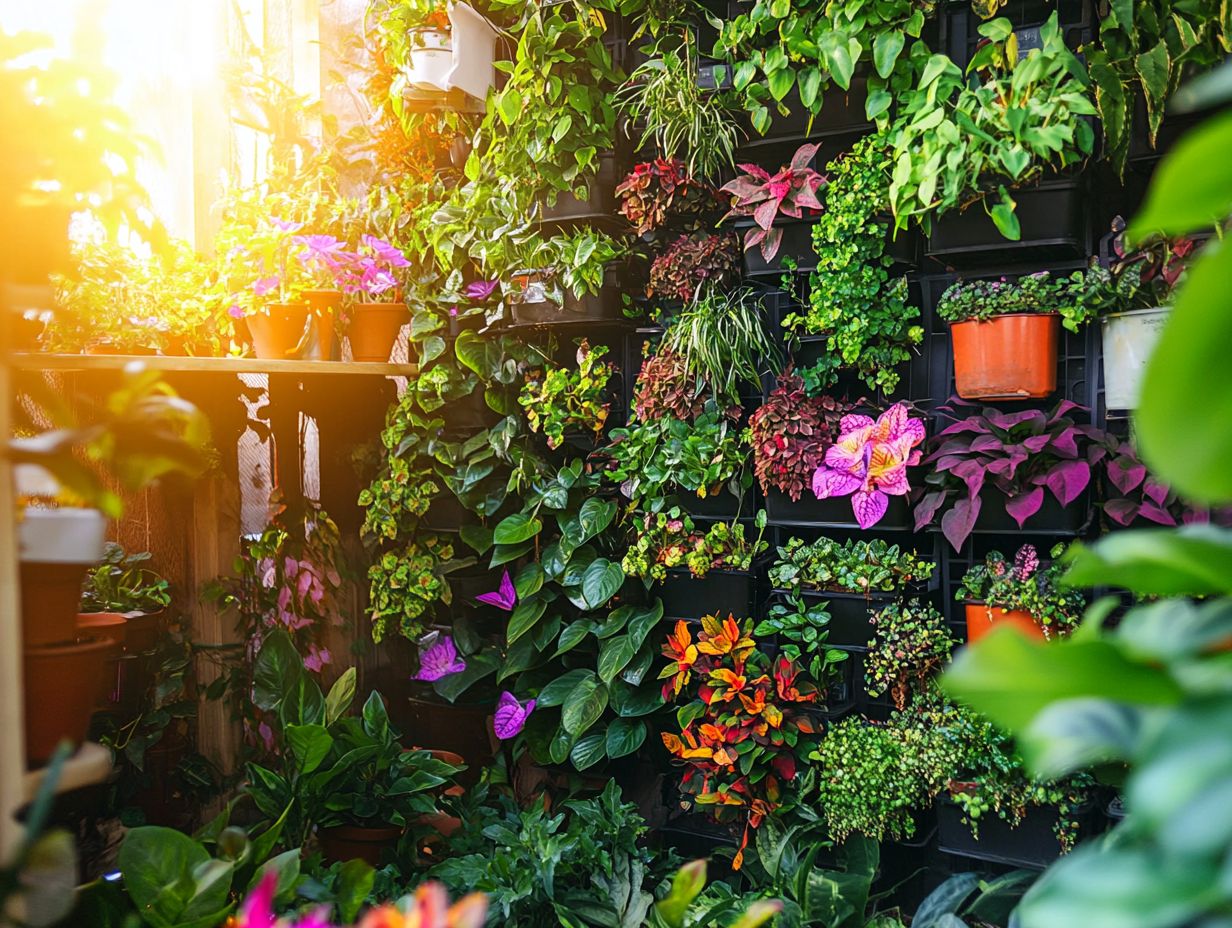
Strawberries are a fantastic choice for your vertical garden, especially in hydroponic systems designed for smaller spaces. These juicy gems bring fresh flavor right to your kitchen and add aesthetic charm to your indoor garden, making them a favorite among gardening enthusiasts.
Their unique growth habits make them perfect for vertical planters, allowing for a continuous harvest throughout the growing season. Monitor light exposure, humidity, and nutrient levels for the best results.
With a bit of care, nurturing these delightful berries becomes simple. Adopting a vertical gardening setup enhances airflow and reduces the risk of pests or diseases. Regularly check the pH levels in your hydroponic system to ensure that your strawberries receive the right balance of nutrients.
When it s time to harvest, picking the berries at their peak ripeness amplifies flavor and stimulates further fruit production, resulting in an abundant yield. This combination of effective care and innovative methods makes vertical gardening an enticing option for both novice and seasoned growers.
2. Lettuce
Lettuce stands out as an exceptional choice for vertical gardening. It is particularly well-suited for hydroponic systems due to its rapid growth cycle and minimal space requirements. This versatile leafy green thrives indoors, letting you enjoy a steady supply of fresh produce for salads and sandwiches while enriching your kitchen garden.
With the right care techniques, indulge in multiple harvests of crisp, nutrient-rich lettuce throughout the year. In your vertical garden, a range of lettuce varieties such as romaine, butterhead, and loose-leaf can thrive, each offering unique textures and flavors to enhance your culinary creations.
Proper care includes maintaining optimal nutrient levels and providing adequate lighting, whether it’s natural sunlight or supplemental sources. Effective pest management strategies, such as introducing beneficial insects or using organic pest deterrents, can further protect your harvest.
When it s time to reap the rewards, using techniques like cut-and-come-again enables continuous leaf production, ensuring your vertical garden remains a vibrant source of greens for all your meals.
3. Juicy Tomatoes: A Gardener’s Delight
Tomatoes are a versatile and rewarding choice for your vertical garden, especially when utilizing hydroponic methods that enhance nutrition and maximize space. These beloved fruits not only bring vibrant color and flavor to your meals but also thrive abundantly in an indoor vertical setup.
When selecting tomato varieties for vertical gardening, consider indeterminate types, which keep growing and producing throughout the season. Varieties like ‘Cherry’ or ‘Roma’ are excellent choices, as their sprawling growth habit makes them easy to train on trellises.
Caring for these plants involves regular pruning and providing ample support to ensure the fruits develop without overburdening the branches. Consistent watering and nutrient-rich solutions will significantly enhance their growth and flavor.
As the plants mature, get ready for a satisfying harvest within 60 to 85 days your indoor garden will be bursting with flavor!
4. Herbs
Herbs are one of the finest choices for indoor vertical gardens! They are not only great for cooking but also add delightful aromas and decorative appeal. Growing herbs like basil, mint, and cilantro in vertical planters helps you maximize your space while infusing your meals with fresh, vibrant flavors.
These resilient plants flourish in hydroponic systems and require minimal upkeep, guaranteeing a steady supply of home-grown herbs throughout the year.
Herbs such as rosemary, thyme, and oregano bring a variety of flavors that elevate your culinary creations. Their low-maintenance nature makes them suitable for both novice and seasoned gardeners. Just regular watering and occasional pruning will keep them thriving!
Beyond their kitchen use, these lively plants enhance your home d cor by introducing a soothing touch of greenery. This creates a calming ambiance.
Incorporating herbs into your vertical gardening transforms the aesthetics of your living space and nurtures a sense of well-being. Bring a refreshing hint of nature right into your home!
5. Spinach
Spinach is a fantastic choice for your vertical garden. It thrives in hydroponic systems that provide the perfect environment for growth. This nutritious leafy green is delicious in salads and smoothies and a fantastic ingredient for cooking. What s better than growing your own spinach?
With proper care and maintenance, you can enjoy a continuous harvest of fresh spinach throughout the growing season.
When cultivating spinach vertically, it thrives best in good soil with consistent moisture. Ideal temperatures are between 60-75 F. It s crucial to monitor nutrient levels since spinach appreciates slightly elevated nitrogen for robust leaf growth.
Regular inspections for pests and diseases are essential. Maintaining good air circulation helps keep your plants healthy.
Harvesting spinach is simple; pick the outer leaves first, allowing the inner ones to keep growing. This extends your harvest period. With a bit of care, you can revel in a flourishing vertical garden brimming with fresh spinach all season long!
6. Peppers
Peppers, whether sweet or hot, are perfect candidates for your indoor vertical garden! With space-saving techniques and hydroponics, you can create an environment that fosters optimal growth.
These vibrant vegetables not only enhance your culinary creations but also thrive in compact spaces, making them ideal for home gardeners. With the right care and support structures, enjoy a bountiful harvest of fresh peppers year-round!
Among the many varieties available for vertical cultivation, bell peppers and jalape os shine with their versatility. Each type has unique light and water needs. For instance, bell peppers thrive on ample sunlight and consistent moisture to produce juicy fruits.
On the other hand, the fiery jalape o prefers slightly less water but requires vigilant pest control to fend off common garden nuisances.
By using high-quality gardening supplies, such as nutrient-rich fertilizers and efficient drip irrigation systems, you can boost your yields significantly. Incorporating trellises or hanging planters maximizes your vertical space and promotes proper airflow, leading to healthier, robust plants.
Don t miss out on the joy of growing your own peppers! Start your indoor vertical garden today and enjoy fresh ingredients at your fingertips!
7. Cucumbers
Cucumbers are an excellent choice for your vertical gardening endeavors. Their natural climbing ability pairs beautifully with hydroponic systems, allowing you to maximize both space and yield. Renowned for their refreshing taste and versatility in salads and various dishes, cucumbers can thrive in indoor vertical gardens when given proper care and attention.
With the right support and optimal growing conditions, you can enjoy a bountiful harvest right from your kitchen. Utilizing vertical space promotes healthier growth by optimizing sunlight exposure while streamlining watering and pest management.
Ensuring adequate airflow is essential in preventing mold and pests. This makes vertical gardens particularly advantageous for cucumber cultivation. When planting, be sure to use nutrient-rich soil that retains moisture to facilitate maintenance.
Regular checks for diseases and pests are important. Opt for organic solutions whenever possible. As your cucumbers mature, remember that careful harvesting techniques such as cutting rather than pulling can enhance your yield by encouraging further production.
With thoughtful attention and care, you can relish a continuous supply of these crisp vegetables throughout the growing season.
8. Kale
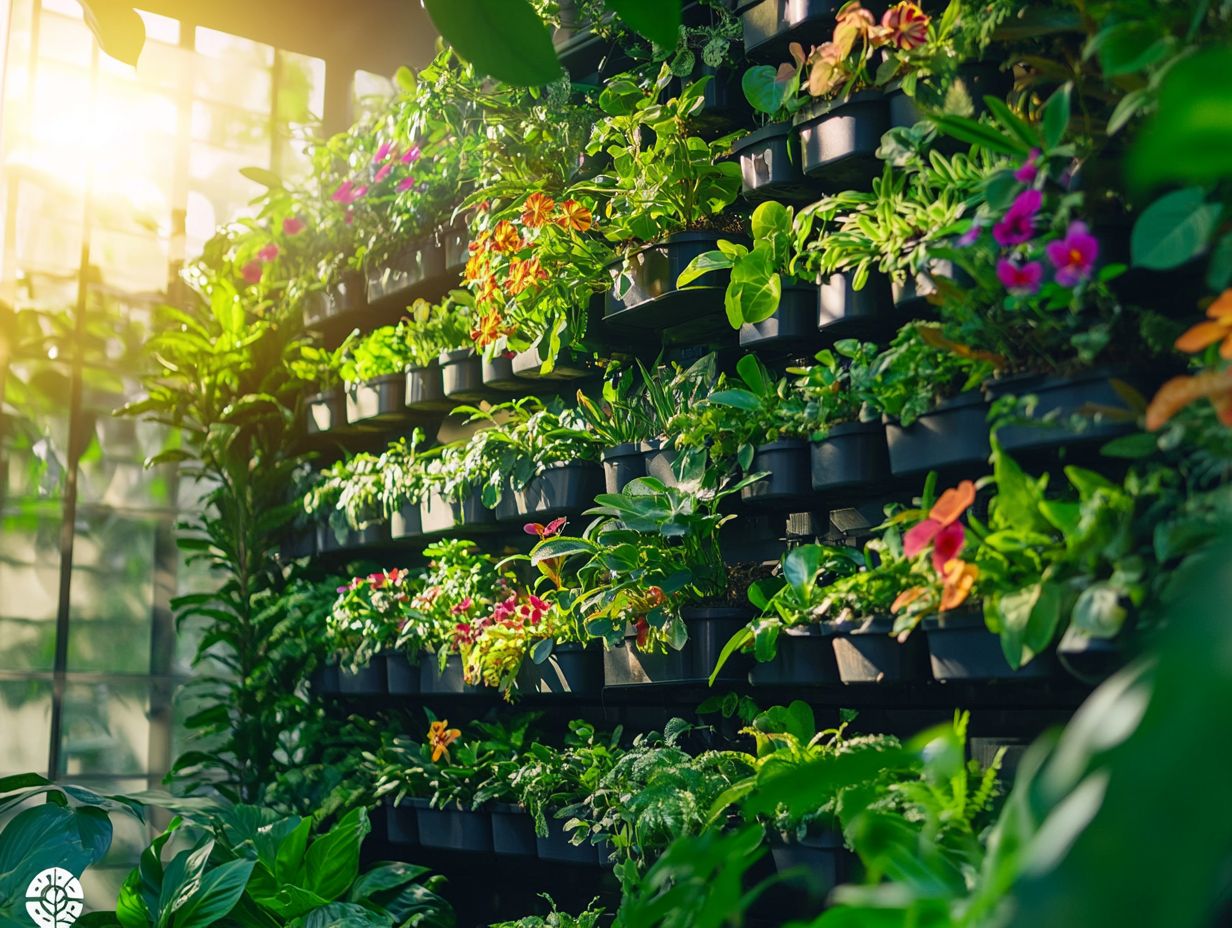
Kale is a true powerhouse of a vegetable that thrives beautifully in vertical gardening setups, especially within hydroponic systems designed to provide optimal nutrition and growth. This nutrient-rich leafy green is perfect for smoothies, salads, and all your culinary creations, making it an invaluable addition to your indoor garden.
With the right care and support, you can enjoy a continuous supply of fresh kale throughout the growing season. One standout benefit of cultivating kale vertically is the efficient use of space, making it an ideal choice for urban gardeners with limited room.
Kale flourishes in controlled conditions and prefers cooler temperatures between 60 and 70 F. Ensuring ample light ideally 12 to 16 hours a day will help your plants reach their full potential.
Proper watering is essential; keep the soil consistently moist, but take care to avoid waterlogging. When harvesting, picking the outer leaves encourages further growth from the center, ensuring a steady yield. With these practices in place, anyone can cultivate a robust kale garden that enhances their home and enriches their diet.
9. Beans
Beans, including varieties like pole beans and bush beans, are ideal for your vertical gardening endeavors due to their natural climbing abilities and adaptability to hydroponic systems. These protein-packed vegetables are not just a source of fresh produce for your kitchen; they also enhance soil health when cultivated in outdoor community gardens.
Consider incorporating varieties such as snap beans and runner beans into your garden. These thrive in limited spaces while requiring sturdy trellises for optimal growth. Regular watering and ensuring they receive adequate sunlight are crucial for maintaining their vitality.
As legumes, they enrich the soil through nitrogen fixation, a process that helps enrich the soil and fosters a healthier garden ecosystem. This harmonious balance between practical gardening practices and benefits to soil quality creates an ideal environment for cultivating beans.
Start your bean garden today for a tasty and nutritious harvest!
10. Radishes
Radishes are your go-to fast-growing root vegetable, especially for vertical gardening setups. They thrive in soil-less growing methods, maturing quickly to provide you with fresh produce in no time. With their vibrant colors and crunchy texture, they are a delightful addition to salads and meals. Plus, they require minimal space, making them perfect for indoor gardening.
These hardy plants flourish in cool temperatures, ideally between 50 F and 70 F. They prefer well-draining substrates that encourage healthy root development. Regular watering is crucial; keep the soil moist but not soggy to avoid issues like root rot. When it s time to harvest, pick them promptly as they reach maturity for the best flavor and texture, usually within three to four weeks of planting.
The convenience of vertical gardening saves space and enhances air circulation, reducing the risk of pests and fostering a productive growing environment.
11. Carrots
Carrots are an exceptional choice for your vertical garden, adapting beautifully to soil-less growing methods that optimize plant nutrition. This results in a vibrant and flavorful harvest. Renowned for their versatility in cooking, these root vegetables can thrive in containers or vertical planters, providing you with a fresh supply of produce right from your kitchen.
With the right care, you can enjoy the crunchy goodness of home-grown carrots all year round.
Growing carrots in these setups maximizes your space and promotes healthier plants by reducing the risk of pests and diseases that often plague traditional garden beds. Since carrots thrive in loose, well-draining soil, it s crucial to ensure that your vertical system offers adequate aeration and moisture retention.
The harvesting process is rewarding; simply pull the roots out gently to avoid damage. Enjoy the satisfaction of cultivating these nutritious delights with minimal effort. Regular watering and nutrient checks will significantly enhance their growth, making vertical gardening a sustainable and gratifying choice for carrots.
12. Squash
Squash, whether you prefer summer or winter varieties, is a fantastic addition to your vertical garden. These vibrant vegetables thrive beautifully in soil-less growing methods, enhancing both your meals and gardening experience, especially in limited spaces. With the right care, you can enjoy a generous harvest of squash throughout the growing season.
One of the standout benefits of growing squash vertically is improved air circulation, which helps reduce disease risk and maximizes sunlight exposure for healthier growth. Ensure they receive adequate watering and balanced nutrients tailored to their needs. A warm climate with ample sunlight will yield the best results.
As those delicious fruits develop, using trellises or sturdy cages will support their weight, making harvesting easy and less labor-intensive. With thoughtful planning, you’ll be rewarded with a prolific squash crop, perfect for all your culinary creations.
Frequently Asked Questions
1. What are the best hydroponic plants for vertical gardens?
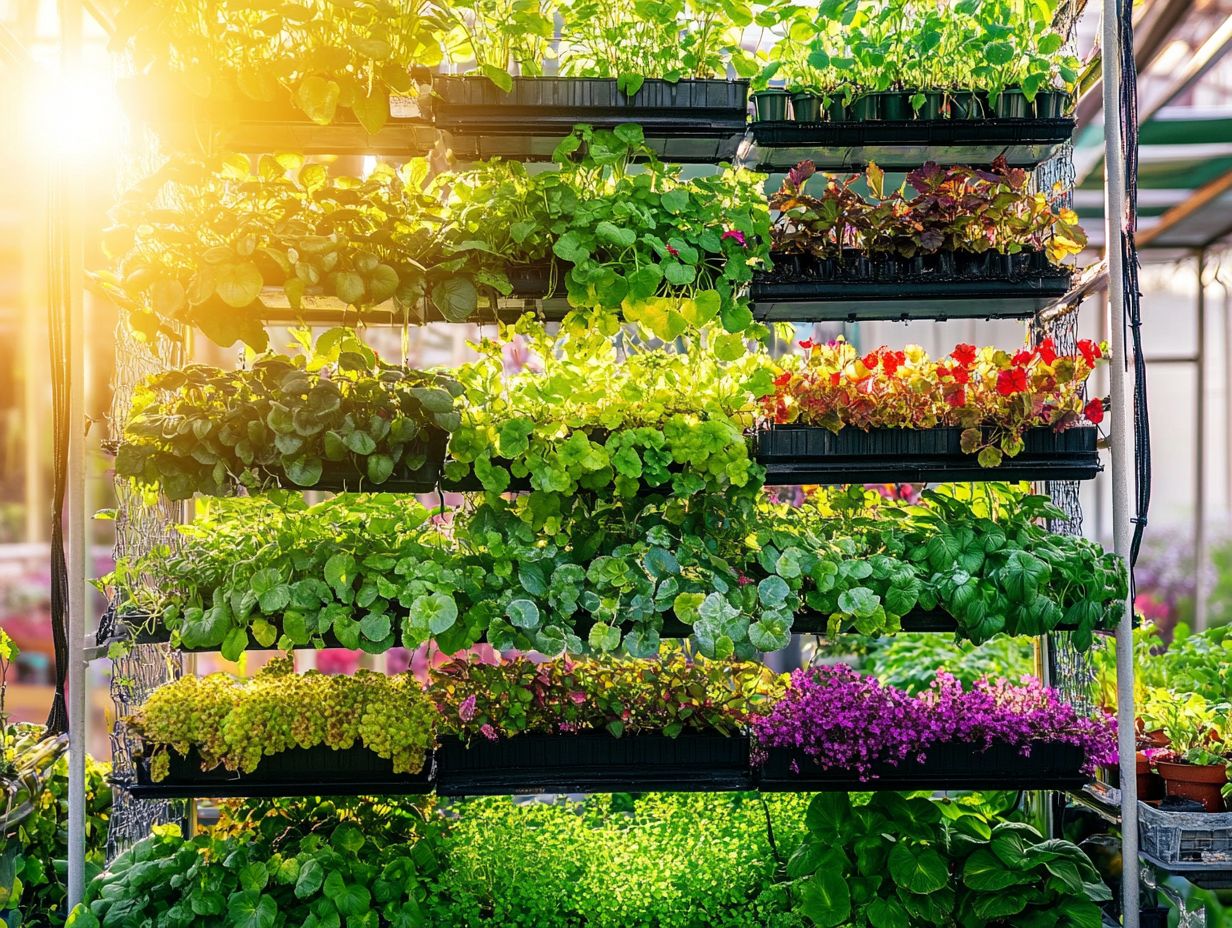
Some of the best hydroponic plants for vertical gardens include leafy greens like lettuce, herbs like basil and parsley, and smaller fruits like strawberries.
2. Can I grow root vegetables in a vertical hydroponic garden?
Root vegetables like carrots and radishes are not ideal for vertical hydroponic gardens, as they require more space for their root systems to grow. However, smaller varieties like beets and turnips may be suitable.
3. Do I need special equipment to grow hydroponic plants in a vertical garden?
No, you do not need special equipment. However, a hydroponic system designed for vertical gardening and a good light source are necessary to provide adequate light for the plants.
Start your vertical gardening journey today and enjoy the many benefits of growing fresh produce at home!
4. What are the advantages of growing hydroponic plants in a vertical garden?
Vertical hydroponic gardening uses space efficiently. It eliminates the need for soil, reducing the risk of pests and diseases.
You’ll find it easy to access your plants for watering and harvesting.
5. Can I grow flowering plants in a vertical hydroponic garden?
Absolutely! You can grow a wide range of flowering plants in a vertical hydroponic garden.
Consider popular choices like pansies, petunias, and impatiens to brighten your space.
6. How do I maintain a vertical hydroponic garden?
To maintain your vertical hydroponic garden, regularly check and adjust the nutrient solution. Keep an eye on plant growth and prune as needed.
Don’t forget to clean the system regularly to prevent algae and bacteria buildup!

